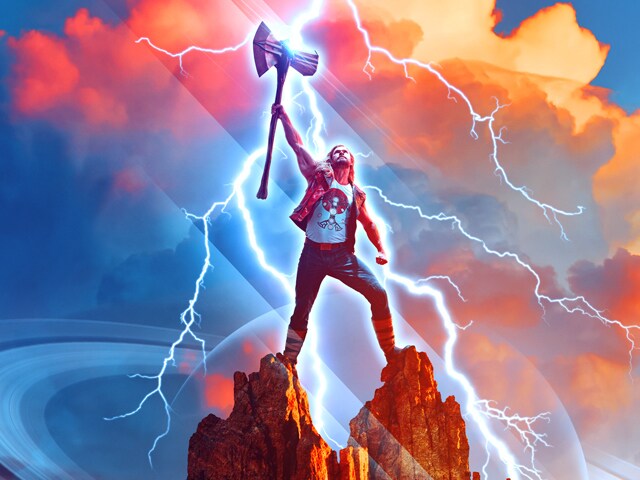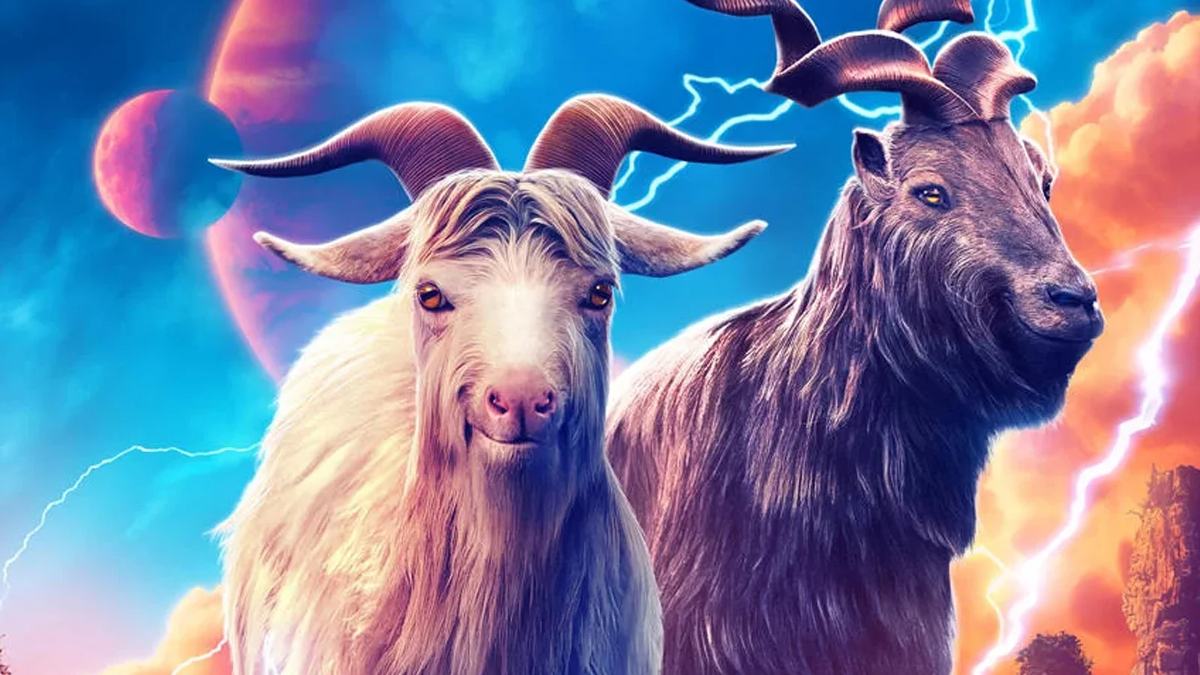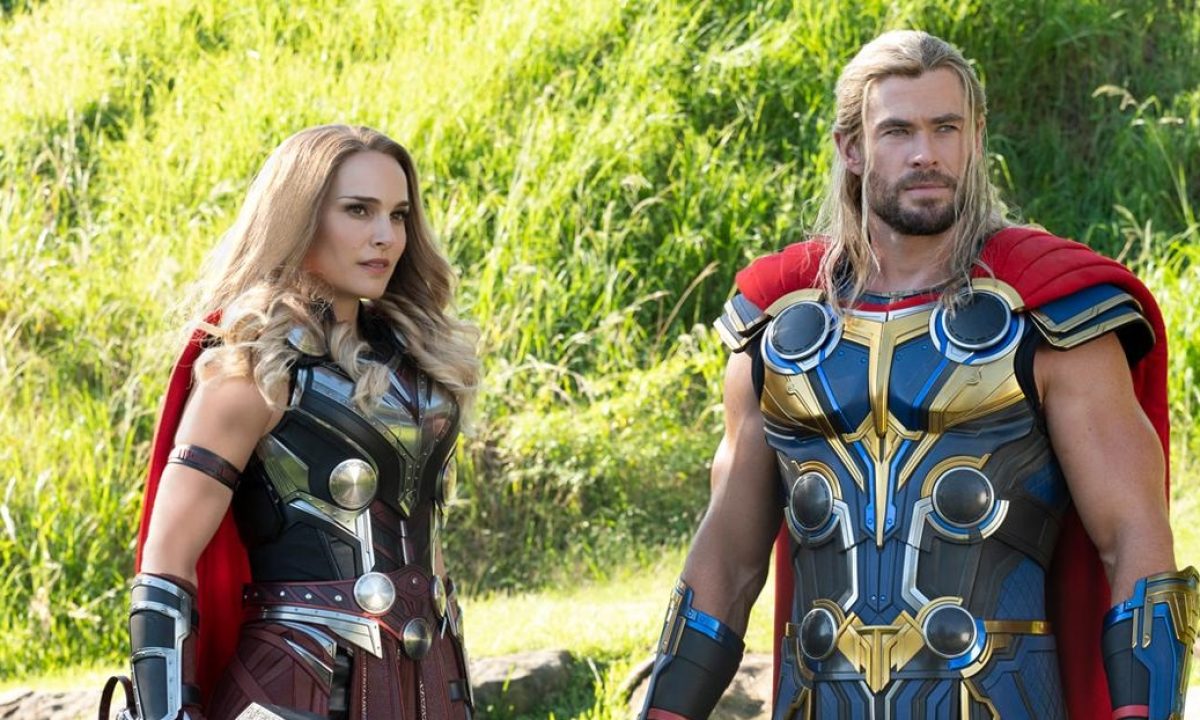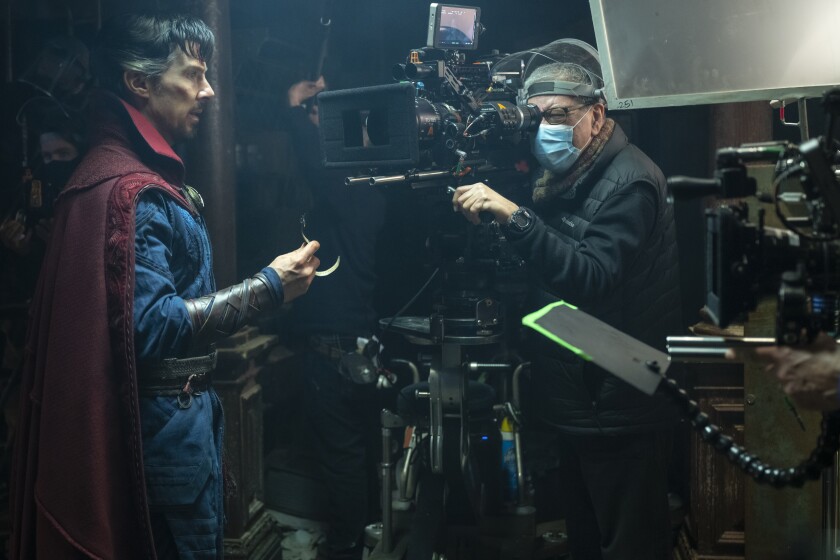Thor: Love and Thunder is easily Marvel’s purest comedy to date and arguably the funniest Taika Waititi film since What We Do In the Shadows. At the same time, I can understand why it is so divisive. It can easily be read as an irreverent slap to the face for a certain faction of pious superhero movie fans—a self-parodic take on the genre’s idolatry, self-seriousness, and theocratic underpinnings. Waititi very smugly revels in the role of the heretic—weaponizing crude humor and sly winks to undermine conventional cape-centered storytelling. He blatantly exposes the Thor franchise for its silly, “cinema sin” inconsistencies (as Don Shanahan nicely outlines in his 25yl review). He downright effaces and emasculates his titular star with absurdist bits, childish tattoos, and self-mockery. He even extends his satire to the entire pantheon of western civilization, tossing gods/demigods (Zeus, Hercules) of Greek mythology into the mix.
The result is a snarky satire that confidently emanates a resplendent lowbrow energy—a fluffy, neon-coated, empty-headed lark. From its omnipresent hair-metal needle-drops to its lightning-saturated/heavy-metal aesthetic, Thor 4’s wicked levity & facetiousness puts forth a tone that closely resembles a smarmy aftershave commercial. Subversive infantilism fills nearly every frame. Like a jester figure, Waititi takes jabs at every trope he’s inherited: cackling at the costumes, the props, and the heroic gravitas of his beloved cast of comic book characters. His puerile punchlines and thorny barbs are endless. With unabashed glee, he’s created a 200-million-dollar gag movie. This is Mel Brooks on acid—a Viking-propelled Blazing Saddles. It’s as silly as Spaceballs, as spoofy as Scary Movie, as wacky as The Naked Gun, and nearly as clever as Galaxy Quest. It’s a big-screen, Monty Python-style sketch comedy — a big-budget lampoon hiding a gigantic heart underneath its buffoonery. That’s right: beneath the Mjolnir-laden insanity and sardonic excess, there’s also a heartwarming story.

From the get-go, the half-brained witticisms and anarchic glibness conjure up the pretense of a dumb summer comedy. Waititi’s edgy adolescent take on Thor is adorably daffy. Awkward and clumsy gestures comically deflate moments other superhero films play completely straight. This is not your ordinary superhero treatment. What kind of a noble warrior would recruit innocent, rosy-eyed youth to join arms for the final showdown? Waititi doesn’t blink an eye at the blasphemous inanity of this proposition. Why should he? Illogicality is the essential syntax of comedy. For formalists, however, comedy on such a stage flirts with sacrilege. Even if critical pundits won’t explicitly admit their disdain toward the genre, it is ubiquitous: hidden behind the dismissive put-downs and snarky commentary. Comedy has a long, illustrious history of being repeatedly panned by serious-minded moviegoers. It signifies too much freedom. It exhibits too much play. Its dissolution of narrative norms and its disregard for rules is unmooring—destabilizing traditional “high-minded” metrics of continuity and symmetry. Therefore, it need be maligned, marginalized, or muted as an inferior artistic agenda.
But comedy can still be transcendent and sublime. Just take Zeus, played by Russell Crowe. Crowe gives an electric performance: he’s raucous and raunchy and inflated with campy theatricality. His accent is arrantly wrong, his outfit is garish, and his acting laughably over-the-top. For these very reasons, Crowe lights the film on fire as Taika leans into the Zeus segment with similar gusto: matching Crowe’s exaggerated mannerisms and manic energy by deploying wacky CGI gimmicky during a lightning-bolt performance. Somewhat dethroning the infamous Greek God with gleeful debauchery, Waititi also pens a steady stream of self-referential quips regarding bacchanalian orgies. Threesome hijinks aside, this sequence serves as an impudent microcosm of the entire movie—insofar as it is formalistically wonky yet deliriously entertaining. It openly celebrates its tonal tawdriness—shamelessly strutting about like a denuded kernel of popcorn bric-a-brac. But don’t let the gilded sheen fool you—Love and Thunder’s fatuousness conceals a deviously meaningful dénouement. Yes, there’s a poignant pulse under all the zaniness.

New Asgard: A Cheeky Facsimile
Perhaps the most conspicuous example of Love and Thunder’s near-constant self-parodying occurs in New Asgard. In a brilliantly meta maneuver, Waititi showcases a troupe of A-list Hollywood leads (Matt Damon, Melissa McCarthy, Sam Neill) playing our central cast (Loki, Jane, Odin) on a cheesy amusement park stage. Sure, this but another example of a Hollywood comedy banking in on the easy gimmick of shoehorning in superfluous cameos. That said, the moment is also darkly satiric and overtly carnivalesque. Very subtly, it foresees a hypothetical future where the sanctity of the now-dominant Marvel Universe is passé. It gives us a glimpse of comic book lore as an outmoded, nostalgia commodity: demoted to a modest low-stakes stage play. We literally witness a surrogate cast of hammy actors entertaining a smattering of ogling bystanders. In doing so, it reminds us that Marvel’s mythological reign has a shelf-life. Marvel will one day be but a vestige of the distant pace, and when this happens, spaces like New Asgard will be forced to bank in on cheap marketing ploys.
At the same time, this meta New Asgard vignette lovingly lauds and sanctifies the surviving history and legacy of bygone narrative currencies. In a way, the remarketing of New Asgard likens Marvel to similar cultural milestones, such as Shakespeare. The town represents both the romantic timelessness and the ill-fated decline into antiquity that all genres, mythologies, and industries face. Waititi uses the city’s touristy reformations as a multi-layered metaphor: as a eulogy and a tribute to the gradual attrition of all empires, and franchises. The jarring artificiality and existential pandering of New Asgard illustrates the fact that all powerful forces (be they superheroes, idols, trends, or economies) have ephemeral expiration dates. New Asgard is a resilient relic, a cadaverous grift, a vaudevillian corpse — it speaks to the recurring historical pattern of diminishing demands. After the wave of popularity crashes, gratuitous merchandising and desperate diversions tend to replace exigency as the creative ecosystem sustains itself by peddling former glories. (Perhaps, New Asgard is the foreboding image of Marvel’s conjectural Phase 8).

For now, at least, despite a wave of premature doomsday takes, Phase 4 isn’t yet showing legitimate signs of Marvel in decline. In fact, 2022’s slate of Marvel films showcases some real promise. I feel like Waititi has finally made the first Marvel movie that feels like an auteur doing exactly what they want to be doing from start to finish. Sam Raimi’s Multiverse of Madness showcased interludes of his signature style and flair for horror, but it was woefully bogged down by multiverse gobbledygook. Thor: Love and Thunder, on the other hand, leans into its comedic underbelly and never relents. It is quite apropos then that Love and Thunder also feels like a moment of spiritual reckoning for Marvel. In some ways, it feels like a god flagellating itself — insofar as the execs and gatekeepers at Marvel licensed and permitted a creator to do more than prod and poke at its secular religiosity; going far beyond light mockery, Love and Thunder literally sneers and jeers at the whole pageantry of the studio’s signature product — toying with it so much it seemingly turns it into a hackneyed farce.
I’m not denying that countless Marvel movies (Deadpool, Guardians of the Galaxy, etc.) were riddled with moments of wit, humor, and levity. But these minor self-deprecatory bits and self-debasing asides still catered to the same fundamental fervor. With Love and Thunder, Waititi pushes the levers of self-satire full throttle. It starts with a montage chronicling the absurdities of Thor’s many transformations (from buff to obese to buff again/from binocular to monocular to binocular again/from Viking love to sheep-dog love to human love to heartbroken). It makes fun of Thor’s narcissism, his weaponry, and his garb. And it undermine the dramatic third act with explosive shenanigans.
The effect of this persistent silliness achieves many ends:
- It humanizes Thor as a relatable manly man—a Himbo who can oscillate at the snap of a finger from a dad-bod to a god-bod.
- It reinforced the notion that, at bottom, superhero archetypes are juvenile and goofy.
- It caricatures the entire genre — mocking the superhero canon’s erratic, slapdash, and “lazy” incoherencies.
Ironically enough, much discourse since Love and Thunder’s release has been outrage over Waititi’s own supposed “laziness”—namely, his dismissive attitude toward making a Marvel movie in general. However, the nonchalance Waititi has exhibited during his press circuit feels perfectly complementary to his filmmaking sensibilities. His ludic, somewhat slovenly, and yet very libertarian stance toward the material is part and parcel with his overarching ideology—Waititi seems to be philosophically intent on avoiding the tyrannical sanctimoniousness of taking what he does too seriously.
This doesn’t mean he doesn’t care. To question Waititi’s creative passion is equally preposterous, obtuse, and downright insulting. The entire film is a love letter to comedy, to moviemaking, and to ludic theatricality. Waititi obviously committed years of steadfast effort towards making a most singularly burlesque superhero comedy. It’s not sloth at play: it’s an artist’s conscientious repudiation of the dogmatic, hyper-fascist obsession with cinematic perfection.
His directorial looseness is purposely salacious — courageously provocative. It’s the natural recourse of enlightened easefulness. Waititi seems to say: why nitpick or fastidiously micromanage every detail if the result only ends up stifling creativity with stiffness and rigidity? Hence, he overlooks blemishes, adds off-kilter cuts, saturates the margins with visual wisecracks, and pushes humor to its clownish limits: all for the sloppy sake of glorious playfulness. The lighthearted hijinks and light-footed spontaneity (i.e. the viral /controversial “screaming goats” were a happenstance mash-up of a Taylor Swift song) are not flaws, but features — they complement his childlike ethos.

Thor’s Underappreciated Depth: Childlike Comedy Vis-à-vis The Adult Drama
Speaking of children, Love and Thunder is suitably populated with kids. Yes, Thor may himself be a veritable man-child, but actual children also play a deceptively large role in the film. In a flashback sequence, baby Thor accompanies his mother to battle. Our villain, Gorr (a sublimely dead-serious Christian Bale), kidnaps a whole pack of young Asgardians. Gorr is on a revenge tour: hellbent on avenging the wrongful death of his own daughter. As a result, children become both catalysts and victims in the film’s plot dynamics.
Fittingly enough, Bale plays his stern, grief-stricken role absolutely straight. He is the only actor who seems to actively care about putting in a dignified performance. As a result, he represents the classic actor of prestige. He feels as if he’s been purloined from a more “serious” superhero movie. He also embodies the perils of holding oneself accountable to an impossible metric of excellence. Gorr’s character arc highlights how the pursuit of hyper-competence parallels psychopathic violence in many ways. Stuck in a comedy, his sociopathic efforts are perfectly undercut by the juvenilia surrounding him — turning him into an apt metaphor for methodical fascism.
As articulated through Bale’s “elevated” take on the role, Gorr is blinded by fanatical indignance. His hate has sublimated into godlike madness — transformed into an all-encompassing desire to overpower and snuff enemies. Yet, Gorr’s solemn crusade is really but a cover-up for a broken heart. It’s all the byproduct of ego and pain, run amok. And ultimately, his nefarious doggedness finds solace through a moment of vicarious understanding. That’s right: Gorr actually never surrenders to his formidable foe. Instead, he reconciles his anger in a moment of emotional catharsis. This unorthodox finale feels like a revelation for Marvel. We don’t merely sympathize with his villainy. We witness his entire pathological agenda (indicative of any sober and ominous antihero) crumble entirely.
The ending of Love and Thunder is thus beautifully idealistic. Sure, it’s jarring to shift from devil-may-care comedy to a surprisingly emotional finale, but I think Waititi handles the transition quite gracefully. Making the entire final battle sequence completely moot and in vain is both hilarious and potent! It is also cinematically complex. Gorr’s de-escalatory epiphany occurs during a resonant shot of Thor cradling Jane. Waititi shows this image of loss and heartbreak through Gorr’s eyes, and then creates a match-cut to the opening shot of Gorr cradling his own daughter (in precisely the same manner). By visual cues alone, the parallelism hits: Gorr understands loss is ubiquitous, omnipresent, and timeless. This layered visual dialectic is exponentially more intriguing than another defeated villain. It offers us a genuinely redemptive and uplifting epiphany — a radical example of how image and likeness have the power to evoke empathy.
It’s also quite interesting that Waititi includes a direct visual allusion to Georges Méliès’ A Trip to The Moon just a few sequences prior. The homage takes place when Thor and company crash into Gorr’s black-and-white planet. The moment of impact itself occurs in a flat, two-dimension shot. As the ship nosedives and the laughing goat pull it down to the ground, Waititi returns the film’s optical orientation to a three-dimensional terrain. Very abruptly, however, the film has transitioned from festive/rainbow-colored CGI to a bleak landscape shimmering in black and white. We’ve moved from iridescent postmodern cinema to its chiaroscuro origins.
Taika makes a concerted effort to highlight the double entendre taking place to cleverly and symbolically signal a pause on the preceding levity. This is why the entire showdown with Gorr remains starkly lit in art-house black-and-white. The film has now transported to a world where love, fun, humor, and goofiness are overpowered by aggressive solemnity. We have left the lurid domain of the comedy and entered the draconian domain of the dignified drama.

It’s a stretch, but one reading might even claim Thor’s journey to Gorr’s planet takes him back to the origins of cinema for a specific reason. Perhaps, Thor is returning to invert the archetypal fabric of its history. It is equally telling that Gorr and Thor’s names rhyme: even their monikers are foils of each other. They also seem to represent opposing ends of the cinematic spectrum in terms of character traits and tonalities.
Therefore, taking all this in mind, the use of that previously mentioned match-cut to signify Gorr’s epiphany is doubly startling. It signifies and reifies the power of the image as an empathy machine that can span centuries, affects, dimensions, nemeses, and polarities. The ending seems to say that seeing another’s suffering can be a transcendent experience: an antidote to despotic lunacy and an affirmative superpower of cinematic intertextuality.
On a thematic level, the shared motif of death and suffering is essential: uniting the two parties. The sight of Thor tending to Jane (suffering from cancer: a modern epidemic) directly recalls the deathly state of Gorr’s own daughter (dying from dehydration: a more archaic fashion). This conflation of identities synthesizes our enemies in a communal web of mortal meaning: inspiring Gorr to turn away from hateful power-mongering, to turn toward love.
Very surreptitiously, this mirroring also says something profound about the power of the medium. Waititi seems to be suggesting that images (i.e. film) can act as a radical palliative: becoming potent enough to end the nonstop debauchery of violent rampages, empty spectacles. He seems to be saying humor, romance, empathy, and ego-effacement can be the greatest sludge hammers of all when up against unbridled power. Beneath the rabble-rousing antics, Thor: Love and Thunder reminds us that we are better when we love and nurture what’s leftover instead of killing to amend for what’s been lost.

Marvel Filmmaking As Sabbatical: Why It’s Not So Bad to Have Auteurs Helm Comic Book Movies
Considering this is Waititi’s second Marvel entry, I’m now incredibly optimistic and excited for Sam Raimi to return for another Dr. Strange. I feel like a second go at it will give him the freedom he truly needs to let his Evil Dead-style freak-flag fly. In fact, I’d be stoked for countless other auteurs to get the chance to take a stab at painting their unique style and sensibilities on the Marvel canvas. I can already hear the so-called esteemed, high-minded critics scoffing at this affirmative celebration of auteurs working within the syntactical confines of the Marvel canon. I both empathize with it and honestly think the outcry is a bit overblown. Sure, in an ideal landscape, artists would be free to just do their own thing. But on a practical level, Marvel has become the new “studio system”. In most respects, a big-name director working with Marvel is the equivalent of classical auteurs who cut their chops satisfying Old Hollywood‘s contractual obligations.
I like to think of an auteur’s tenure at Marvel as a sabbatical, or even better, as a prestigious kind of jury duty—after all, it is in some respects a personal sacrifice for the economic viability of the industry. This is not to deny the fact that many auteurs opt-in wholeheartedly: helming a superhero blockbuster is also an opportunity of a lifetime. But even for those who settle or artistically “compromise” when saying yes, it can still be registered as a net positive—a short-term detour from one’s more individuated artistic trajectory rarely tanks a career. And truthfully, it’s not like Marvel has taken over our cinematic language altogether. They’ve become the box office hegemony and a cultural behemoth, no doubt. But the film industry is still immensely diverse and dynamic. Marvel is just the mainstream money-maker—intermittently poaching and repurposing top talents for an interim period.
I recently heard a quote that said if one really wanted to see true creativity/artistry, we’d force every director to make the same exact movie for a year and admire the incredibly nuanced differences between them. With Love and Thunder, I’ve regained my confidence that this could apply to the future of Marvel Studios—so long as they continue to not only recruit visionaries but also let them do their own thing.

If there’s one positive about the confusing multiverse system they’ve created, it is that it establishes this possibility. Just look at the Thor franchise on the whole. The first two Branagh/Taylor entries and the latter two Taika Waititi entries are about as incongruous as any four films in a single franchise can be—tonally, narratively, aesthetically. And yet, why shouldn’t this be permitted in a multiverse? Just as characters can leap in and out of other worlds and narratives, artistic sensibilities should be able to morph and mutate with equal liberality. I’m all for it. At this point, let Waititi finish his Thor trilogy (given the perfect Hercules setup he nodded at in the end credits) and then give the reigns to someone else — say, Terrence Malick. Why the hell not?
If you think I’m crazy to pick Malick, think again. The New World is an inarguable masterpiece and he pulled that narrative from the Pocahontas canon! How awesome would it be to see Thor moseying about in existential crises—pining on Nordic ontology with metaphysical melancholy! When Malick is finished with his jury duty, let Eggers take a turn—blend the Marvel formula with our new wave of horror. Let Thor marry The Northman—I’d pay to see that in a second.
While we’re at it, Marvel can do the same with its other entries. Give Assayas Ant-Man, Stephen Chow Shang-Chi, Wes Anderson Loki. Let them all paint their idiosyncratic aesthetic personalities all over the multiverse. It’ll be a win-win—for us and the industry. And the best part is all these movies will go beyond just keeping the theaters afloat; they’ll also inspire endless newbies/budding cinephiles to go check out IMDB. These novice movie fans will in turn research and deep dive into these auteurs’ filmographies. I can’t promise they’ll all dig everything, but I’d put good money they’d grow to like a lot of their findings.



Thanks Don! Loved you’re write up as well. Equally fair takes, on opposite ends of the subjective spectrum.
your* (doh!)
That’s a wonderfully rich and well-composed piece. Great work, Paul!